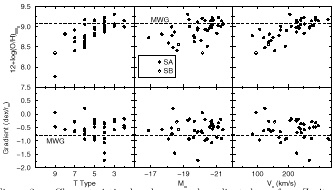


Because oxygen is readily accessible spectroscopically, its abundance provides a convenient tracer of metallicity distribution in a galactic disk. I begin by discussing the Milky Way oxygen profile and then follow up with a summary of general results for a large number of other spirals.
Data for oxygen in the Milky Way disk were taken from the following papers: Shaver et al. (1983), the first major survey of abundances in galactic H II regions; Vílchez & Esteban (1996), a focused study of H II regions at large galactocentric distances; and Maciel & Köppen (1994), where a large number of galactic type 2 planetary nebulae were used to map abundances in the disk. Abundances were generally derived in these papers by combining measured line strengths directly with atomic data and ionization correction factors as described in Osterbrock (1989).
Figure 1 shows 12+log(O/H) versus galactocentric distance in kpc for the Milky Way, where symbol shape indicates the data source. Also included are the recent B star results from Smartt & Rolleston (1997). Numbers in square brackets in the legend give 12+log(O/H) at the sun's distance (8.5 kpc) and the slope in dex/kpc, respectively, for least squares fits. Parameter uncertainties are given in parentheses. The sun's position (Grevesse & Noels 1993) is indicated with an ``x''. Error bars here and in subsequent figures show typical uncertainties.
Besides the presence of a negative metallicity gradient, Fig. 1 implies the following. (1) The galactic oxygen gradient flattens beyond 10kpc, according to the Vílchez H II region data. (2) The B star oxygen profile is consistent with H II region results inside of 10kpc and shows no flattening beyond 10kpc. (3) The oxygen abundances in planetary nebulae are systematically less than in H II regions at corresponding distances by roughly 0.14 dex, qualitatively consistent with the idea that planetary nebulae represent an older, less metal-rich population than H II regions.
Turning now to the consideration of spiral galaxies generally, large surveys of O/H in extragalactic H II regions include those of McCall (1982; 40 galaxies), Vila-Costas & Edmunds (1992; 32 galaxies), and Zaritsky, Kennicutt, & Huchra (1994; 39 galaxies). Detailed results for O/H in individual spirals can be found in these papers. To show general findings here I have extracted characteristic abundances (2) and gradient slopes from Zaritsky et al. and present them in Figure 2 as functions of galaxy morphological type (T type), absolute blue magnitude MB, and maximum circular velocity Vc in km/s. All three of these independent parameters are indicators of galaxy mass, where smaller T type indices, more luminous integrated blue magnitudes, and larger rotational velocities generally correspond with more massive spirals. Gradient slopes are shown in dex / r0. Normal and barred spirals are shown separately using filled and open symbols, respectively. Parameters from the Shaver data for the Milky Way are indicated in Fig. 2 with dashed lines, where I have adopted 11.5 kpc for the isophotal radius (de Vaucouleurs & Pence 1978). I note that while isophotal radius is employed as the normalization standard here, use of effective radius (the half light radius) or kiloparsecs produces similar results. The choice of normalization standard is discussed by Garnett in this volume.

|
Figure 2. Characteristic abundances and gradient slopes from Zaritsky et al. (1994) plotted against morphological T Type, absolute blue magnitude, and circular velocity. Regular and barred spirals are shown with filled and open circles, respectively. Parameters for the Milky Way shown in Fig. 1 for Shaver's data are indicated with dashed lines. |
Two points are implied by Fig. 2:
(1) Characteristic abundances increase with galaxy mass, while
gradient slopes are uncorrelated with this parameter; and
(2) Characteristic
abundances in normal and barred spirals are indistinguishable,
but
barred spirals appear to have flatter gradients. Both of these results
have been noted previously. Garnett & Shields (1987) plotted
characteristic O/H values against galaxy mass for numerous spirals and
found a direct correlation between these two
parameters, while Pagel et al. (1979) first suggested that
barred spirals may have flatter gradients.
2 The characteristic abundance
is the abundance at 0.4 r0 as
determined by a least squares fit to the data, where r0 is the
isophotal radius at  B = 25 mag arcsec-2.
Back.
B = 25 mag arcsec-2.
Back.